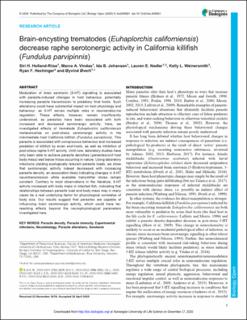| dc.description.abstract | Modulation of brain serotonin (5-HT) signalling is associated with parasite-induced changes in host behaviour, potentially increasing parasite transmission to predatory final hosts. Such alterations could have substantial impact on host physiology and behaviour, as 5-HT serves multiple roles in neuroendocrine regulation. These effects, however, remain insufficiently understood, as parasites have been associated with both increased and decreased serotonergic activity. Here, we investigated effects of trematode Euhaplorchis californiensis metacercariae on post-stress serotonergic activity in the intermediate host California killifish (Fundulus parvipinnis). This parasite is associated with conspicuous behaviour and increased predation of killifish by avian end-hosts, as well as inhibition of post-stress raphe 5-HT activity. Until now, laboratory studies have only been able to achieve parasite densities ( parasites/unit host body mass) well below those occurring in nature. Using laboratory infections yielding ecologically relevant parasite loads, we show that serotonergic activity indeed decreased with increasing parasite density, an association likely indicating changes in 5-HT neurotransmission while available transmitter stores remain constant. Contrary to most observations in the literature, 5-HT activity increased with body mass in infected fish, indicating that relationships between parasite load and body mass may in many cases be a real underlying factor for physiological correlates of body size. Our results suggest that parasites are capable of influencing brain serotonergic activity, which could have farreaching effects beyond the neurophysiological parameters investigated here. | en_US |

